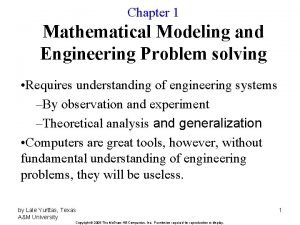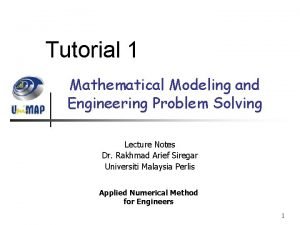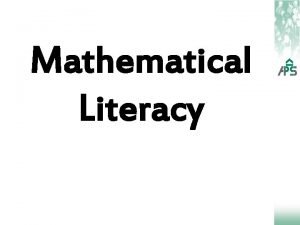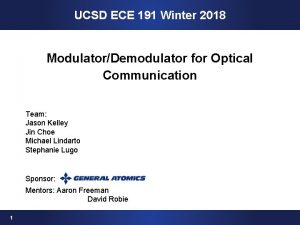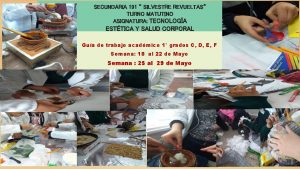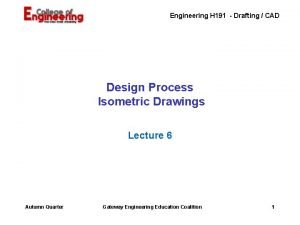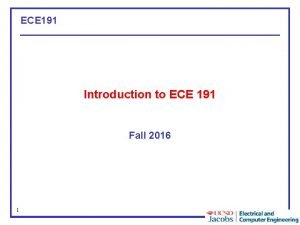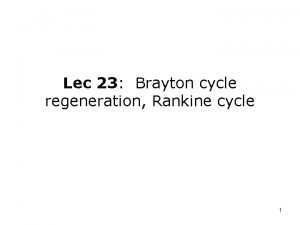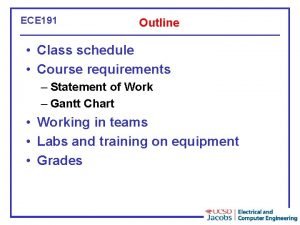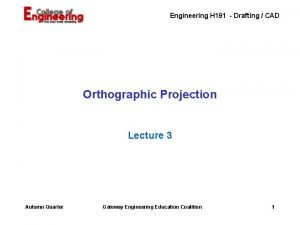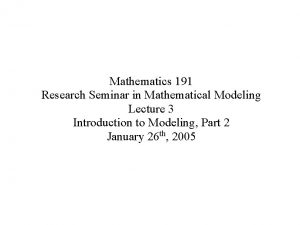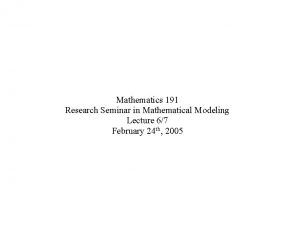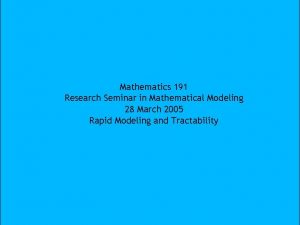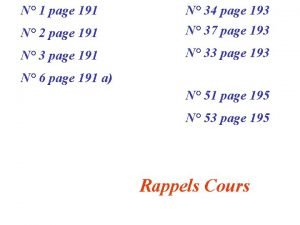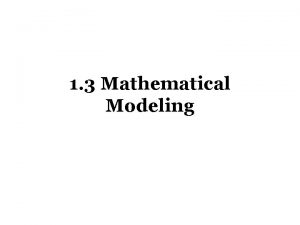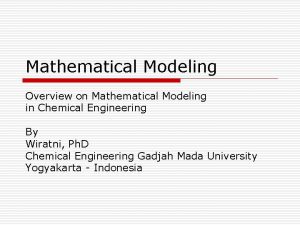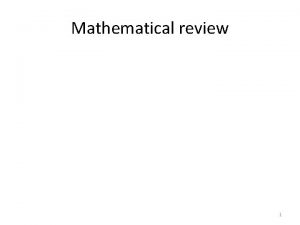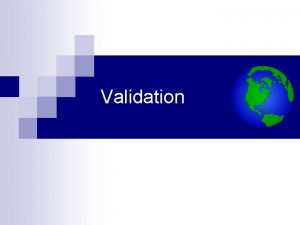Mathematics 191 Research Seminar in Mathematical Modeling Validation

















- Slides: 17

Mathematics 191 Research Seminar in Mathematical Modeling Validation and Simulation I February 10 th, 2005

Project Comments • • Project comments Project two should form groups and start now Formal project requirements will be up online Make sure you send a final prospectus to us by the due date – 2 weeks! • Field trip for validation

Overview • • Syllabus and Projects Introduction to Validation versus Simulation Methods of Validation Vote-Counting and Velociraptor Validation Giving Mathematical Talks Content and Style Presentations

Section Two: Validation and Simulation Over the next two weeks, we’ll go over: • Methods of validation • Statistical methods • Simulation design and analysis • Data generation and distributions • Mathematical Programming?

The Modeling Process • Statement of Problem (abstraction) • Define Model Objective / Objective Function • Definitions and Identification of Variables (background research and common sense) • Assumptions (for tractability) • Establish Informal Relationships Based on System • Construct Mathematical Statements • Construct Base Model • Estimate Parameters • Apply Mathematical Methods • Pure Mathematical Solution • Simulation and Validation • Sensitivity Analysis • Relax Assumptions • Iterate • Assess Model Limitations

The Need for Justification • Validation is the assessment of how closely our model meets a given set of criteria, typically, how well the model represents real-world data. • If we’re using models to make real-world predictions, our model is only effective if it can predict real-world data correctly

Three Options for Validation / Justification 1) Evaluate model using objective function - In the tollbooth model, throughput 2) “Evaluate” (compare) model using another model, with orthogonal assumptions - In the tollbooth model, discrete simulations 3) Evaluate model using real-world data (might be from a similar system, not necessarily equivalent) - What’s the potential problem here?

Another option - Goodness of Fit • We are concerned in many contexts with “goodness of fit” and error - how close we come to predicting actual performance in terms of deviation from sets of data points • Frequently occurs in natural-science contexts • In other contexts, we don't – what about psychological models, for instance? • Statistical tools are coming up later

Simulations and Validation • Simulations play two roles: • As modeling tools, they can numerically evaluate a system over time that is too complicated to solve analytically – usually this means there a very large number of variables, or that there are coupled equations we can only solve numerically. • In addition to being tools, they can be used to generate independent models and data for validation purposes, although we don't necessarily need a simulation to validate our data.

A Very Crude Summary of Simulation Construction • • • Define relevant variables Come up with equations and rules for behavior Implement the rules as pseudocode Implement the rules as real code Evolve the system over time

Evans Hall Elevators, Revisited • Recall that a few weeks ago we were interested in designing optimal algorithms for performance. • In teams of two, write a pseudocode simulation to represent the behavior of the elevators.

How Did Velociraptors Hunt? • • Part 1. Assuming the velociraptor is a solitary hunter, design a mathematical model that describes a hunting strategy for a single velociraptor stalking and chasing a single thescelosaurus as well as the evasive strategy of the prey. Assume that thescelosaurus can always detect the velociraptor when it comes within 15 meters, but may detect the predator at even greater ranges (up to 50 meters) depending upon the habitat and weather conditions. Additionally, due to its physical structure and strength, the velociraptor has a limited turning radius when running at full speed. This radius is estimated to be three times the animal's hip height. On the other hand, thescelosaurus is extremely agile and has a turning radius of 0. 5 meters. Part 2. Assuming more realistically that the velociraptor hunted in pairs, design a new model that describes a hunting strategy for two velociraptors stalking and chasing a single thescelosaurus as well as the evasive strategy of the prey. Use the other assumptions given in Part 1. Here, some constraints and assumptions are given to us by the problem. What sort of mathematical approaches might we use to solve this problem?

How can we hold fair elections in a dangerous or uncertain environment? • Iraq's electoral system is based loosely on our own. Iraq is divided into a certain set of precincts, but turnout is expected to be fairly low, and perhaps unfairly biased towards certain groups. • As an added complication, nobody knows who's really running. • In the US election, random votes were lost on certain machines in certain areas. User and machine error, and rarely, fraud, also contributed to mis-votes. Rerunning an election is costly and highly undesirable. • How can we still determine a “fair” winner in these situations?

Why Give Talks in a Math Class? • It's what mathematicians and nonmathematicians do. • You'll get better at it, one way or another.

A few tips on effective presentation • • Eye contact, posture, body language, volume Tone and voice inflection Face the audience, not your screen or notes Engage your audience through examples and interaction • Power. Point content • Be prepared!

Suggested Outline • • • “Hook” Overview Motivate your problem. Explain prior approaches. Explain your approach. Explain your results. Suggest future work. Applications. Conclude

Fin
 Erickson nursing theory
Erickson nursing theory Dimensional modeling vs relational modeling
Dimensional modeling vs relational modeling Complex impedances
Complex impedances Mathematical modeling and engineering problem solving
Mathematical modeling and engineering problem solving Mathematical modeling and engineering problem solving
Mathematical modeling and engineering problem solving Econ213
Econ213 Mathematical literacy pictures
Mathematical literacy pictures Validation of instrument in research example
Validation of instrument in research example Ece 191 ucsd
Ece 191 ucsd Escuela secundaria 191
Escuela secundaria 191 Iso 191
Iso 191 Radiologie mainzer landstraße
Radiologie mainzer landstraße Article 191
Article 191 H 191
H 191 Ece 191 ucsd
Ece 191 ucsd Brayton rankine cycle
Brayton rankine cycle Ece 191
Ece 191 H 191
H 191



